Cherry Condition
Life Is Just a Bough of Cherries: Native Santa Clara Valley farmer Charles Johan Olson will soon bid farewell to the orchards his ancestors have cultivated for close to 100 years.
For the Olson family cherry orchards--since 1899 a vibrant player in the history of Sunnyvale's harvests--the sun is about to set
By Christina Waters
SHAPE, color, flavor--all these sensations conspire to make cherries irresistible to humans. Telltale pits have been found in Neolithic tombs. Those connoisseurs of luxury, the Egyptians, considered cherries a favorite delicacy, and the ancient Romans bred and crossbred them, arguing incessantly about their healthful properties.
Bite-sized, packed with sweet-tart flavor and blood-red juices, this most accessible of fruits has won a place in popular folk mythology: "Can she bake a cherry pie, Billy boy, Billy boy?" We may test the sheer Americanness of something by equating it with Mom and apple pie, but in the ultimate bourgeois bake-off, a cherry pie separates potential wives from lifelong spinsters.
The adage "Life is just a bowl of cherries" equates this relative of the wild plum with earthly bliss. Orbs of desire, they promise sensory thrills, the pesky pit a mere afterthought that barely breaks the rhythm of pleasure--a rite that seems inextricably linked with welcome spring weather.
A few sweet facts about cherries.
But for Deborah Olson, it's always cherry season. From her cherry-red lipstick to the bunches of red fruit printed across her theme clothing, Deborah Olson eats, sleeps, breathes and faxes cherries. The fourth generation of a family wedded to the seasonal fortunes of Santa Clara Valley agriculture, she operates the Olson fruit stand on the corner of El Camino Real and Mathilda Avenue.
But though the stand still thrives, the trees around it won't do so much longer. This year, the family will lose the remnants of the orchards that have been cultivated by Olsons for close to 100 years.
Old-Growth Logging: Workers still toil in the Olson orchards, removing dead branches to be sold as firewood.
DRIED AND FRESH fruit together perfume the rafters of the old roadside fruit stand, where 60 summers of Olson patrons have polished the hardwood floors to a high gloss. Surrounded by cellophane-wrapped gift packs, pyramids of jams and honeys, and bundles of sun-dried cherries and apricots, Olson is mistress of her domain. Her last phone call was from a catalog customer, and the next one comes from a Chilean grower.
"We're down to 15 acres at this point," she says, with a trace of regret. "Dad still lives here, in the tank house, and Frank Martinez and his family are still here--he was the foreman even when my grandfather was here." Several other workers who've been with the Olson orchards for decades still come daily to work the diminishing fields, clearing dead branches, much of which is now chopped and sold as firewood.
The fruit stand, where Deborah Olson holds down the family business, was built in 1933. "My grandmother Rosie decided to have a fruit stand, so my grandfather built it for her." Now a landmark for generations of fruit lovers, the pit-stop became so successful that it paid for additional acreage over the years.
"The peak season for the cherries is really May and June," Olson says. Like most of her forebears right back to turn-of-the-century Swedish immigrants Carl Johan and Hannah Louise Olson, she spent her girlhood summers picking, cutting and pitting fruit. The hours were long, the work was hot and tedious. While other kids played, the Olsons worked in the orchards--or the fruit stand.
Photo by Christopher Gardner
For generations, Olsons have swung into high gear during that annual onslaught of fruit that seems to ripen all at once. Famous for Bings--prized not only for flavor and vibrant color but also for the ability to hold up under shipping and handling--the Olson name regularly adorned the New York produce markets and auction houses, living up to its "World's Finest Cherries" label. Before a network of highways interlaced California, freshly picked cherries traveled by wagon to Alviso, then by ship to San Francisco. Later they were trucked, along with the substantial Olson apricot harvest, to nearby canneries.
After spending her girlhood helping with the family business, Olson went on to college and got a degree in food and nutrition. She cooked for eight years in France as an apprentice to many of the top chefs, such as Michel Guerard, and at top hotels, such as Hotel L'Hermitage in Monte Carlo. But each summer she came back home, full of energy and ideas. "I began putting together our own fancy fruit packs, then making cherry blossom honey from the beehives we have in the orchard," Olson recalls. She was resourceful in coming up with specialty items to generate sales during slow times--such as salvaging a cherry crop whose beauty was rain-damaged by turning it into gorgeous conserves and jams. This year, she invited guest chefs to come in and demonstrate their regionally made lines of designer condiments.
The Olson catalog, which enjoys longstanding customer loyalty, began seven years ago, and a Web site is almost complete. From her makeshift office behind an antique wooden sorting counter, Deborah Olson puts the finishing touches on the eighth mail-order tome. "Dad farms," she grins, pointing out the window toward C.J. Olson, riding his tractor through a maze of weathered barns. "I do the rest."
"My focus is fresh cherries," Olson happily confesses. "All the rest of this," she points toward mounds of melons, fresh corn and bags of dried apricots, "is fluff." Given this focus--and the realities of Santa Clara's diminishing orchards--Olson has found herself drawn into the world of cherry brokering, with contacts ranging from Washington to Chile. "My main thrust this time of year is getting in Chilean cherries for the holiday," she explains.
Deborah Olson accepts that at most her family orchards have one more summer left. "It's just been five bad years in a row," she sighs. "Last year, for example, was too warm. You need a chilling period between December and February for trees to go into dormancy. Last year we didn't have that. Then we had rain and a lot of fruit was just wiped out. What was salvaged was lower-quality fruit. So I couldn't supply the demand," she says, clearly exasperated. "So you have to take a hard look."
That hard look, on top of disappointing harvests, finally forced the family's hand. Trees will be replaced by a Target store.
"I've been trying to keep this thing alive. Many of our customers are getting old," Olson notes. "They were my grandmother's customers. But we are committed to keeping the fruit stand," she says, protectively. "Most people are amazed that we held on this long. And right in the middle of Silicon Valley!"
He loves to recite the litany of farm projects that make for long days and calloused hands. "I had opportunities to do other things--I went away to college. But I just enjoyed being part of the family tradition. Unfortunately," he adds quickly, "times changed and things are never quite the same as you remember them to be." Olson cites escalating costs--"ten times what they were not so long ago"--and dying trees as conspirators in the destiny he's facing. "I have to think we're fortunate in having any option at all."
Farmer Olson says he saw the handwriting on the wall as early as 1985, when declining trees brought out UC-Davis experts and a terminal diagnosis. "Consecutive years of heavy rains have killed the roots. One day it looks healthy, the next day the tree just falls over. Now we've got piles of wood, of dead limbs, ten feet high and 80 feet long. The whole thing's just falling apart."
Olson's voice rises in pitch as he discusses a series of hassles involving increased regulations. "You can't irrigate, you can't spray, you can't burn when you want to." He says he understands about other people's needs, but there are just too many people, too suddenly and too close. The orchard, once part of a living sea of trees carpeting the valley floor, is now a minuscule oasis in the midst of concrete, condos and freeways. "What they don't realize is that they've covered up the best land in the valley," he says wistfully.
One by one, Olson's fellow farmers have either retired or moved north to more rural areas. "The smarter ones," he chuckles, "either went ahead and developed early or moved to Yuba City, Winters, Marysville. Some of them just hung it up."
"It's not about getting rich," Olson observes. "A farmer is really someone, as Thomas Jefferson said, who's never jealous of another person's vocation. The tougher it gets, the tougher you get. Yes, there is a romance to farming, I really do think so," says Olson, who says that no one could be more disappointed about the impending loss than he is. Olson also says that once the old barn, the tank house and the 15 acres of trees are gone, he might continue farming somewhere else. "I've been looking around, exploring soils--that soil down in Salinas is just perfect, just incredibly optimum--but I'm 61 years old, and orchards take at least seven years to develop."
Deborah Olson is reaching out to a cherry future by forging a new empire that reaches from the fertile fields of Chile to the tables of Stars and Masa's. In the early 1990s, she started noticing Bing cherries from Chile showing up at the pre-dawn produce market in San Francisco. "At first it was inconsistent in quality, really rather marginal for the first couple of years. And then they started getting more sophisticated," she recalls, "and the fruit got better." And the fruit came in during the Chilean spring, which was the California winter, allowing Olson to offer her cadre of loyal customers the ultimate luxury: fresh cherries for Thanksgiving and Christmas.
"I called all my cherry customers and told them that I'd found great cherries." Cementing her alliance, Olson went down to the Chilean orchards for an extended tour. "It was incredible--their orchards were beautiful and had these big, black, delicious cherries." A network was born--and extended by Olson's probes into the cherry harvests of Washington and Oregon. She successfully courts top restaurants, whose menus feature the cherries she orders from her newly developed sources. Thanks to her savvy timing, Jacques Pepin will feature Olson-label cherry conserve on his KQED fall cooking series.
Back on Olson's home turf, behind the little white frame fruit stand, shallow trays of cherries dry in the sun. A fork lift sits in the shade of an equipment shed. The three-story galvanized iron barn stores a forest of boxes and thickets of ladders that once reached the highest boughs but now climb to nowhere. Across the aggregate of saws, dolleys, shovels, tractors and trucks cluttering a cool, dusty storage area, the fields bake in the noontime haze, punctuated by a few noisy roosters and a sleeping dog. If you squint, you can imagine the waves of green receding as far as you can see in every direction. Close your eyes and catch the heady scent of cherry blossoms. Open your eyes, and today's trees, bark still beautiful as spun silver, languish in faded glory.
Inside the fruit stand, lined with cherry-print wallpaper and signs proclaiming "Fresh Cherries," all is healthy abundance. Fancy apricots and cherry jam fill the table where Deborah Olson napped as a baby. Cherry biscotti, cherry ginger snaps and dried cherry oatmeal cookies proclaim a cherry heyday. "I really don't want to change a thing," Olson says, glancing over at Helen Wozniak, working the cash register in front of a wall of historic family photographs. Wozniak, Olson explains, was her grandmother's friend and hairdresser. "Grandma called her to come help fill in one day at the fruit stand." That was 25 years ago, "and she's been here ever since."
With luck, and the support of the city of Sunnyvale, Wozniak and the Olson fruit stand will remain at the corner of El Camino Real and Mathilda for many seasons to come. But the musky aroma of fallen fruit fermenting under the great trees, the dappled light filtering through uplifted branches--that magical transformation of valley soil into sweet summer memories is no more. Things change. Yet somehow the image of all those orchards is infinitely sweeter than one more rush hour.
[ Metro | Metroactive Central | Archives ]
This page was designed and created by the Boulevards team.
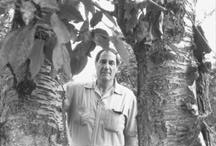
Christopher Gardner![[line]](/gifs/line.gif)
![[line]](/gifs/line.gif)
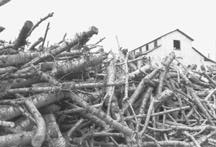
Christopher Gardner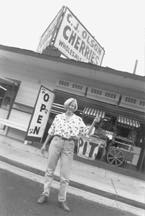
Pit Stop: Deborah Olson keeps a cherry attitude at the family fruit stand.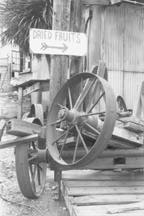
Ironically, as the trees begin to play themselves out--victims of blight, mercurial weather and old age--the Olson cherry empire has expanded way beyond the valley's borders.
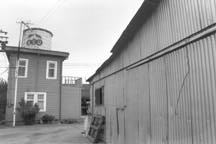
WATCHING his family's lifework gradually chain-sawed into oblivion, Deborah's father, Charles Johan Olson, struggles to maintain a farmer's stoicism. "Oh, I love all the work of the farm," says the raw-boned, still-handsome patriarch, who lives in his faded tan overalls. "I do things as they come along. Plowing, irrigating, pruning, then more irrigating, harvesting."
C.J. Olson's Cherry Stand, corner of El Camino Real and Mathilda Avenue, Sunnyvale (408/736-3726). Open 9am6pm MondaySaturday; longer hours during holiday season.
From the October 10-16, 1996 issue of Metro
![[Metroactive Dining]](/dining/gifs/dining.gif)